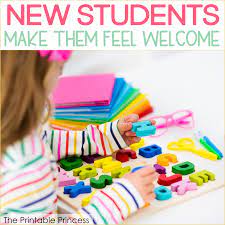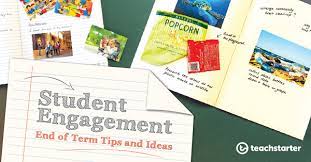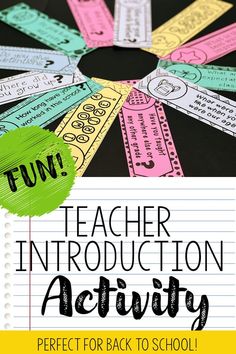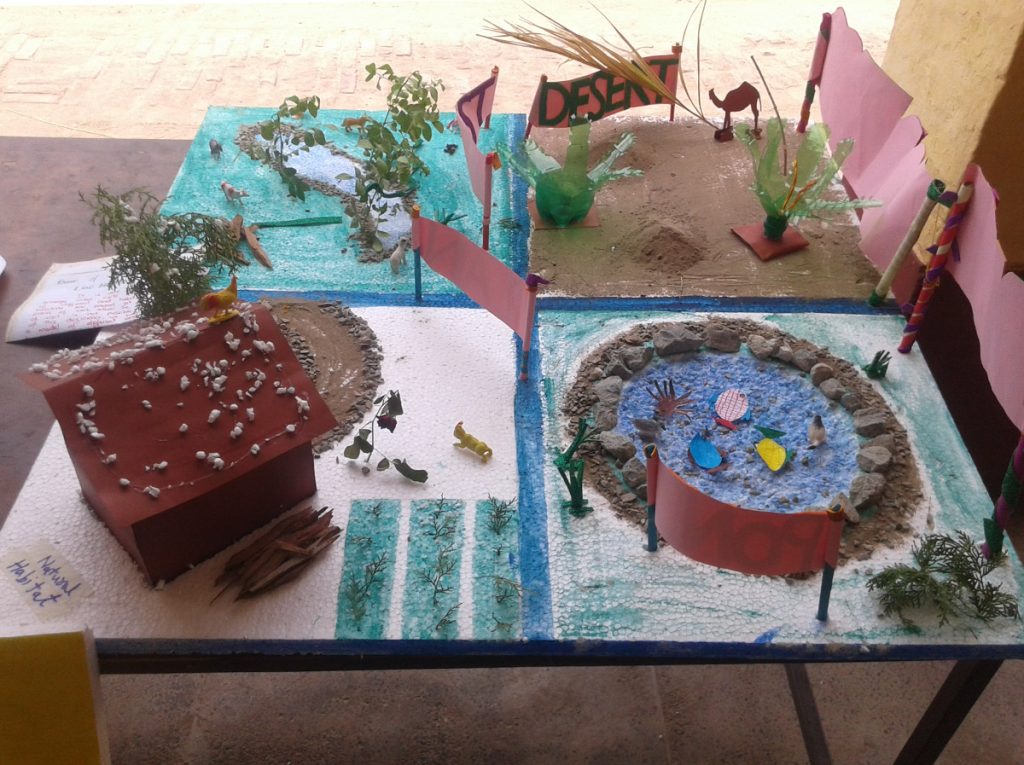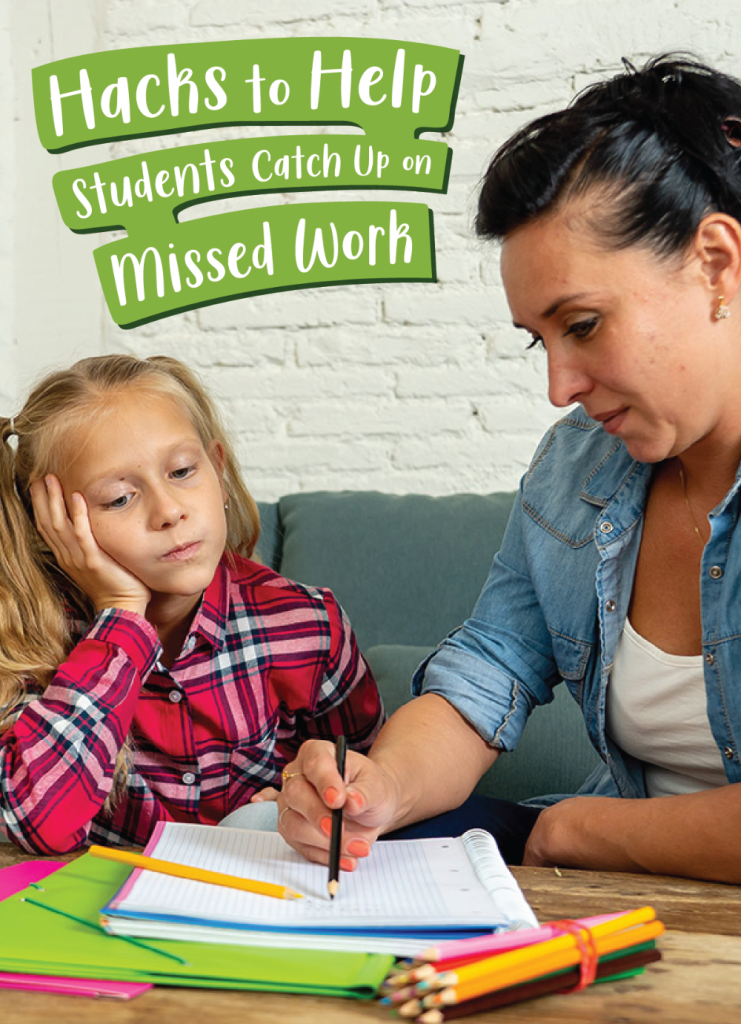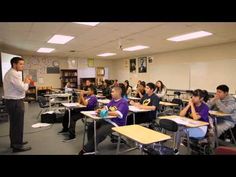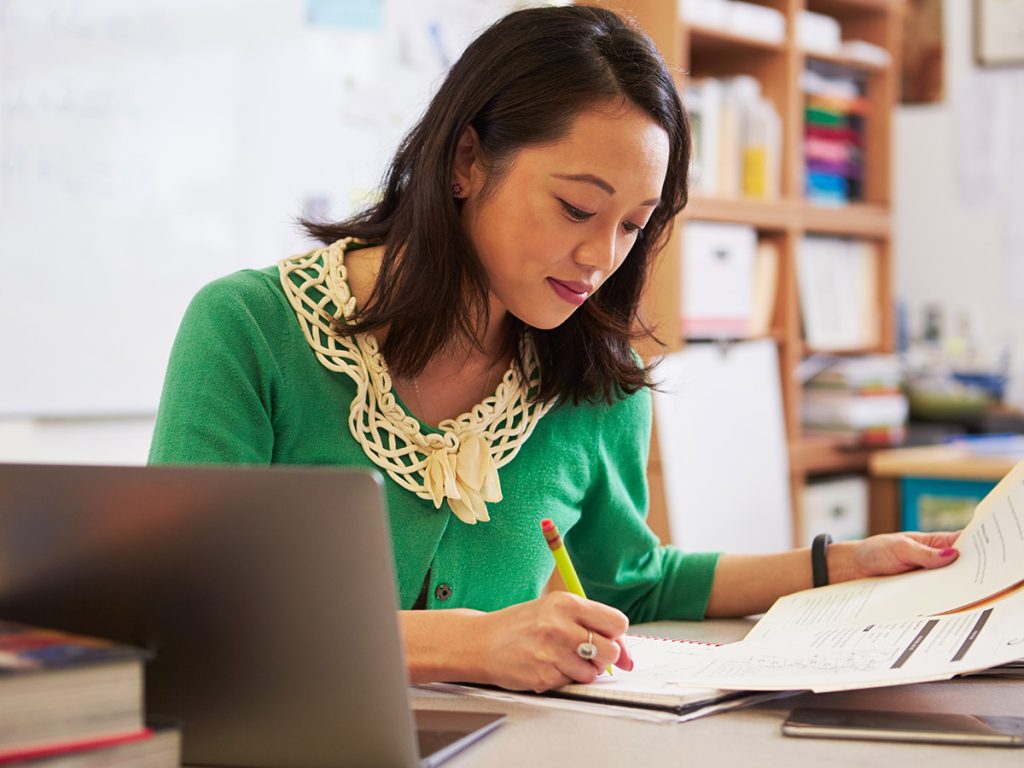Welcoming a new student into a classroom can be a big transition, not just for the student, but also for teachers and classmates. Whether it’s the middle of the year or the start of a new one, integrating a new face into the mix should be handled with care and positivity. Here are 7 tips for making that new student feel right at home.
1. Prepare the Class: Before the new student arrives, discuss with your class about the importance of being kind and welcoming to newcomers. Encourage them to think about how they would feel in a similar situation.
2. Assign a Buddy: Pairing the new student with a buddy can make the transition smoother. This buddy can show them around, introduce them to other students, and be a familiar face in times of need.
3. Give Them A Tour: Personalize their welcome by giving them a tour of the classroom and school. Pointing out key areas like restrooms, the cafeteria, and common meeting spots will help them navigate on their own.
4. Involve Them in Activities: Engage the new student in class activities right from the start. This inclusiveness helps to break down any initial barriers and promotes bonding with other students.
5. Maintain Open Communication: Check in regularly with the new student to see how they’re doing both academically and socially. Open lines of communication show that you are approachable and care about their well-being.
6. Create ‘About Me’ Opportunities: Encourage your class to share facts about themselves so that everyone gets to know each other better. This could be through an ‘About Me’ poster or an interactive session where everyone shares something unique about themselves.
7. Facilitate Group Work: Include the new student in group work where they can contribute and collaborate with others on tasks and projects. This is an effective way to integrate them into the class’s social fabric.
By following these tips, teachers can foster an environment that is welcoming and inclusive for all students, making transitions less intimidating and more enjoyable for everyone involved.
Student Engagement | End of Term Tips and Ideas
Engaging students toward the end of the term can be a challenge for educators. With thoughts of summer break or upcoming finals taking precedence in their minds, keeping students focused calls for creative and effective strategies. Here are some tips and ideas to boost student engagement during the crucial final weeks:
Incorporate Interactive Review Sessions:
Turn review sessions into interactive games like Jeopardy or trivia contests. This makes studying for finals fun and can foster a little friendly competition.
Offer Reflection Opportunities:
Encourage students to reflect on their learning by using journals or collaborative projects where students can share insights about their progress over the term.
Connect with Real-World Application:
Tie lessons to real-world events or issues, making the content more relevant and engaging for students, which can also help them see the value in what they have learned throughout the course or term.
Create a Theme Week:
If feasible, organize a theme week where every lesson connects to an exciting topic, making the last few weeks more memorable and engaging.
Encourage Goal Setting:
Work with students to set personalized goals for the remainder of the term. This serves as a motivation booster and keeps them focused on what is important.
Facilitate Student-Led Teach-Backs:
Allow students to teach part of a lesson. This peer-teaching approach not only empowers them but also encourages deeper understanding of the material as they prepare to teach it.
Utilize Technology:
Use educational technology apps to create interactive and engaging activities. These can bring variety to your regular teaching methods and help hold student interest.
End-of-Term Projects:
Assign a project that allows students to utilize various skills they have learned. Projects should be challenging yet achievable and allow for some degree of choice, thus catering to diverse interests.
Implement Feedback Sessions:
Have regular check-ins with students about what is working for them and what isn’t. This shows that you value their input and are willing to adapt to keep them engaged.
Plan Ahead for Fun Days:
Incorporate days that are focused less on curriculum and more on learning-related fun — like educational movies or field days with learning stations pertaining to different course materials.
By implementing these strategies, educators can better maintain student engagement right up until the final bell rings, ensuring that end-of-term learning is as robust as it is at any other point in the academic calendar.
Back To School 2024: A Treasure Trove Of Resources, Activities & Worksheets For Teachers
The beginning of the school year is a time full of excitement and anticipation. Teachers are looking for fresh resources and activities to kick-start the year on the right foot. As we approach Back to School 2024, here’s a compiled list of useful resources, fun activities, and educational worksheets to help teachers engage their students from day one.
Resources
1.Teacher’s Pay Teachers (TpT): A well-known marketplace for educational resources, TpT offers a wide variety of Back to School lesson plans, classroom decor sets, and organizational tools made by teachers for teachers.
2.Share My Lesson: This AFT community provides thousands of high-quality teaching resources including syllabi, lesson plans, and complete units. It covers various topics aligned with standards across grades.
3.Edutopia: This comprehensive hub provides articles, videos, and other resources focused on best practices in education and effective teaching strategies that can be particularly helpful in planning for the new school year.
4.Discovery Education: Offering standards-based digital curriculum resources for K-12 classrooms worldwide, this platform has engaging content that can be used to spice up lessons across different subjects.
5.Canva for Education: Canva helps create stunning visuals for the classroom without needing extensive design skills. It offers templates ranging from presentations to infographics that can enliven any back-to-school session.
Activities
1.All About Me Posters: An engaging activity where students fill out posters with information about themselves which can serve as icebreakers and wall decorations.
2.Time Capsule: Have students write letters to their future selves with their expectations and goals for the school year, to be opened at the end of the year.
3.Find Someone Who… Bingo: Create a bingo sheet with different traits or experiences (e.g., “has a pet fish,” “visited another country”). Students will mingle to find classmates who match each description.
Worksheets
1.Goal Setting Worksheets: Provide worksheets where students can set academic and personal goals for the year.
2.Summer Memories Writing Prompt: A reflective worksheet where students write about their summer experiences which can be shared in small groups or with the whole class.
3.Class Rules Brainstorm Sheet: Engage students in creating a set of class rules by using a brainstorm worksheet. This fosters ownership and understanding of classroom expectations.
These resources are only a starting point designed to alleviate some of the stress of planning at the beginning of an academic year and provide inspiration for class activities that build community and student engagement from day one.
World Environment Day 2020 Classroom Resources and Activities
World Environment Day is an annual event that aims to raise awareness about the importance of protecting the environment and taking action to conserve our planet. In 2020, this day will be celebrated on June 5th, and there are numerous classroom resources and activities available on Teach Starter’s website to help educators engage their students in meaningful discussions and learning about environmental issues.
On the Teach Starter website, you can find a blog post specifically created for World Environment Day 2020 in the UK. The article provides a comprehensive list of classroom resources and activities that can be used to educate students about environmental sustainability and inspire them to become stewards of the environment. These resources cover a wide range of subjects, including science, geography, English, and art.
Teachers can use these resources to teach students about the importance of recycling, renewable energy, climate change, and biodiversity. They can also learn about environmental justice, sustainability, and the impact of human activities on the environment. The article provides links to downloadable resources, such as posters, worksheets, interactive activities, and lesson plans, which can be easily incorporated into classroom teaching.
Apart from individual resources, Teach Starter also offers World Environment Day-themed units of work that provide a structured approach to teaching about environmental issues. These units include comprehensive lesson plans, assessment tasks, and engaging activities to cover various aspects of environmental sustainability.
By incorporating these classroom resources and activities into their lessons, teachers can create an immersive and interactive learning environment that encourages students to think critically about environmental issues and promotes sustainable practices. World Environment Day is not only an opportunity to raise awareness, but also to empower the next generation to take action and contribute to a more sustainable future.
Meet Our Designer Alyssa Creagh | Teach Starter Blog
Introduction:
In this article, we will introduce you to Alyssa Creagh, the talented designer behind Teach Starter’s captivating graphics and visual content. Alyssa’s passion for creativity and dedication to educational design has greatly contributed to the success of Teach Starter’s resources. Let’s delve into the world of Alyssa and see what inspires her creative process.
Body:
1. Early Life and Education:
Alyssa’s journey as a designer began early on when she discovered her love for art and design during her school years. Growing up, she constantly found herself drawing and experimenting with different artistic techniques. This passion led her to pursue a degree in graphic design, where she honed her skills and developed a deep understanding of design principles and software tools.
2. Joining Teach Starter:
After completing her studies, Alyssa joined Teach Starter, attracted by the company’s mission to provide high-quality educational resources that engage and inspire students and teachers alike. With her keen eye for aesthetics and a desire to make a difference in education, Alyssa saw Teach Starter as the perfect platform to showcase her design capabilities.
3. Designing Engaging Resources:
Alyssa’s unique design style and attention to detail have profoundly impacted the visual appeal and effectiveness of Teach Starter’s resources. She understands the importance of creating visually appealing content that engages students and facilitates effective learning. Whether it’s a striking classroom poster, a vibrant PowerPoint presentation, or an interactive digital resource, Alyssa’s designs are crafted with both aesthetic and pedagogical considerations in mind.
4. Collaborative Approach:
Alyssa recognizes the significance of collaboration and teamwork in her design process. She works closely with Teach Starter’s content creators, educators, and other designers to ensure that the design aligns seamlessly with the educational content and goals. By understanding the needs of teachers and students, Alyssa ensures that her designs not only look great but also serve their intended purpose.
5. Inspirations and Creative Process:
Alyssa finds inspiration in various aspects of life, including nature, art, and children’s literature. She believes that creativity is nurtured by exploring diverse sources of inspiration. Her creative process involves brainstorming ideas, sketching initial concepts, and refining designs through iterations. Alyssa pays keen attention to user feedback and continuously seeks ways to enhance her designs and meet the evolving needs of the Teach Starter community.
Conclusion:
Alyssa Creagh’s contribution as a designer at Teach Starter has significantly shaped the visual identity of the company’s resources. Through her creativity and dedication, she has helped make learning more exciting and engaging for students and teachers. Alyssa’s passion for educational design and her commitment to excellence continue to be an invaluable asset to Teach Starter.
Remember, the above response is generated based on the given task.
Hacks to Help Students Catch Up on Missed Work
Introduction:
It is not uncommon for students to fall behind on their schoolwork due to various reasons such as illness, family emergencies, or other unforeseen circumstances. However, it is crucial to provide them with the necessary support to catch up and thrive academically. In this article, we will explore some effective hacks that can help students catch up on missed work and get back on track with their studies.
1. Clear Communication:
The first step in helping students catch up on missed work is to establish clear communication channels. Teachers should proactively reach out to students who have fallen behind and inquire about the reasons for their absence. By understanding their circumstances, educators can provide tailored solutions and support.
2. Create a Catch-Up Plan:
Once the reasons for a student’s absence are identified, it is essential to create a catch-up plan. This plan should include a timeline or schedule that outlines the specific assignments, projects, or lessons the student needs to complete. Breaking the work into smaller, manageable tasks can make the catch-up process less overwhelming.
3. Collaborate with Peers:
Encouraging peer collaboration can be beneficial for students catching up on missed work. Pairing them with classmates who have already covered the material can help them understand concepts and fill in any knowledge gaps. This approach fosters a supportive learning environment where students can help each other succeed.
4. Offer Extra Resources:
Providing additional resources, such as notes, recordings of lectures, or supplementary materials, can assist students in independently catching up on missed work. These resources enable students to review the content at their own pace and further reinforce their understanding.
5. Individualized Support:
Every student’s situation is unique, and extra support may be required for some individuals. Teachers should be willing to offer one-on-one or small group tutoring sessions to help students grasp the concepts they missed. This personalized attention can significantly contribute to their catch-up progress.
Conclusion:
It is vital to create a conducive learning environment where students feel supported when catching up on missed work. By implementing these hacks, educators can empower students to overcome challenges and achieve academic success. Remember, catching up on missed work is not just about 3completing assignments—it is about providing opportunities for growth, resilience, and progress.
7 Tips for Teaching Curiosity 3
Curiosity is the engine of intellectual achievement—it’s what drives us to keep learning, exploring, and pushing the boundaries of what we know. But how can you cultivate a lasting sense of wonder in children? Here are 7 tips for teaching curiosity in young learners:
1.Encourage Questions: Always encourage children to ask questions, no matter how silly or complex. Create an environment where questions are welcomed and celebrated. This means not just answering their queries, but also praising the act of questioning itself.
2.Be Curious Yourself: Kids mimic what they see. Demonstrate curiosity in your own behavior by showing enthusiasm for discovering new information or skills. Share your passions and interests openly and involve children in your learning processes.
3.Explore a Variety of Topics: Expose children to a wide range of subjects and activities to spark their interest. From science experiments to historical stories, from art creation to nature walks—diversity in learning will increase the chances that something resonates deeply with them.
4.Don’t Rush to Answers: When a child asks a question, resist the urge to provide an immediate answer. Instead, guide them on how to find answers on their own through research or experimentation. This develops their investigative skills and teaches them the value of persistence.
5.Create Challenges: Set up scenarios where children need to solve problems or find out information themselves. Challenges stimulate curiosity as they work towards finding solutions and enhance their critical thinking abilities.
6.Offer Resources: Provide books, documentaries, websites, and other informational resources that kids can access when their interest is piqued. Having materials at hand encourages them to take initiative in their learning journey.
7.Reflect on Learning: After delving into new experiences or knowledge areas, take time to reflect with the child on what they’ve learned. Ask them what they found interesting, what surprised them, or what they might want to discover more about.
Fostering curiosity isn’t just about providing information; it’s about creating an atmosphere that values questions and supports discovery. With these seven tips, educators and parents can promote a deep-seated love for learning that will last a lifetime.
Top 10 Teach Starter Blogs of 2018
As the year comes to a close, educators around the globe look back on the wealth of resources and insights gained from educational blogs. Teach Starter, known for its engaging and informative content, has once again impressed with a plethora of blog posts in 2018. From teaching strategies to classroom management tips, Teach Starter has been an invaluable resource for teachers seeking inspiration and professional development.
However, amidst this treasure trove of educational wisdom, some gems have truly stood out. Let’s take a moment to reflect on the Top 10 Teach Starter Blogs of 2018:
1. Building Empathy in the Classroom: This heartwarming piece highlighted inventive ways to introduce and develop empathy among students. The blog provided actionable strategies for educators looking to nurture a more compassionate classroom environment.
2. Tech Tools for Teachers: A favorite among tech-savvy educators, this post compiled an essential list of technological tools designed to enhance learning experiences and streamline teaching processes.
3. Creativity Unleashed: Art Integration Ideas: Artists and non-artists alike found inspiration in this blog that explored the integration of visual arts into various subject areas, showcasing how creativity can significantly enhance student engagement.
4. Math Games that Make Learning Fun: Who said math can’t be fun? This popular post listed interactive math games that not only make learning enjoyable but also reinforce essential mathematical concepts.
5. Mastering Classroom Management: A definitive guide for many teachers, this blog provided effective strategies for establishing and maintaining a positive classroom environment conducive to learning.
6. The Ultimate Guide to Teaching Reading: Literacy is paramount, and this extensive guide was acclaimed for its comprehensive look at teaching reading skills across all grade levels using diverse methodologies.
7. Science Experiments for Budding Einsteins: Capturing the wonder of science, this post was packed with simple yet fascinating experiments that turned classrooms into laboratories of discovery.
8. Innovative Assessment Methods: Moving beyond traditional testing, this insightful article introduced various formative assessment techniques that cater to different learning styles and help track student progress accurately.
9. Mindfulness in Education: Educators looking to bring mindfulness practices into their classrooms were grateful for this blog, which offered practical advice and exercises aimed at reducing stress and increasing focus among students.
10. The Teacher’s Toolkit: Essential Resources: Last but not least, this highly bookmarked post served as a one-stop-shop for teachers in search of must-have resources like lesson plans, organizational tools, and classroom decor ideas.
The Teach Starter team has indeed outdone themselves in 2018 by providing these top-tier articles full of guidelines, tips, and activities that have enriched classrooms around the world. As we usher in a new year filled with potential, educators eagerly anticipate more innovative content from Teach Starter’s dedicated contributors.
4 Benefits Monitoring Student Progress Classroom
Monitoring student progress in the classroom is a critical component of effective teaching and learning. By keeping track of how students are doing, teachers can adapt their instruction to meet the needs of their students and help ensure that all students are making progress. There are several benefits to monitoring student progress, and we explore four significant advantages below.
1. Helps Identify Areas for Improvement
When teachers regularly monitor their students’ progress, they gain valuable insights into which areas each student is excelling in and where they might need additional support. This tailored approach allows educators to focus on specific skills or concepts that a student hasn’t mastered yet, ensuring that instruction is personalized and targeted to improve student performance.
2. Encourages Student Accountability
Regular assessment and review of student work can foster a sense of responsibility in learners. When students are aware that their progress is being observed and assessed, they are more likely to take ownership of their learning. This heightened accountability can lead to increased motivation and effort as students strive to demonstrate what they have learned.
3. Enables Early Intervention
Consistent monitoring allows teachers to detect academic or behavioral issues early on before they become more significant problems. With early intervention, teachers can provide immediate support through remediation, tutoring, or other strategies to help the student get back on track quickly. Early detection coupled with prompt action can be pivotal in helping a student achieve long-term success.
4. Supports Data-Driven Decision Making
Tracking progress generates data that educators can use to make informed decisions about their teaching. By analyzing this data, teachers can identify trends among individuals or the whole class and adjust their methods accordingly. Data-driven decision making helps align the curriculum with the students’ needs and identifies the most effective teaching strategies leading to better learning outcomes.
In conclusion, monitoring student progress is an essential practice in education that supports personalized learning, promotes accountability, allows for timely interventions, and facilitates informed instructional choices. By prioritizing this approach, educators can significantly enhance the learning experience for all students ensuring every child has the opportunity to succeed academically.
Would You Rather Questions – 10 Uses in the Classroom
“Would You Rather” questions have become a popular engagement tool in classrooms around the world. These questions pose a dilemma in the form of a question, asking people to choose between two options, and are a great way to get students thinking critically and engaging with each other. Here are 10 ways teachers can use “Would You Rather” questions in the classroom:
1. Ice Breakers: At the beginning of the school year or before starting a group project, “Would You Rather” questions can help students get to know one another.
2. Writing Prompts: They serve as excellent starters for journals or creative writing tasks. Students can elaborate on their choices by explaining their reasoning.
3. Critical Thinking: These questions can foster decision-making and critical thinking skills, especially when both choices have potential downsides.
4. Debates: Students can be divided into groups based on their choice and engage in debates to defend their positions.
5. Subject Integration: “Would You Rather” questions can be tailored to any subject, from history (e.g., Would you rather live in ancient Rome or ancient Egypt?) to science (e.g., Would you rather explore space or the ocean?).
6. Filler Activities: They’re great for transitional times or when there’s an unexpected extra five minutes in the schedule.
7. Team Building: They can reveal shared interests or values among students, encouraging teamwork and collaboration.
8. Understanding Perspectives: These questions may help students understand different viewpoints and empathize with others’ decisions.
9. Classroom Management: Instead of traditional rewards, let students answer a “Would You Rather” question as a fun break.
10. Learning Preferences Assessment: Teachers can use them to gauge student interest in topics or activities (e.g., Would you rather do a group project or write a paper?).
Integrating these questions into classroom activities not only promotes an engaging learning environment but also helps develop social-emotional skills among students.
